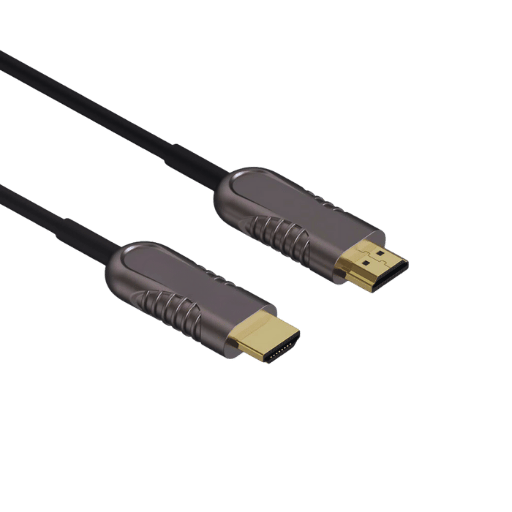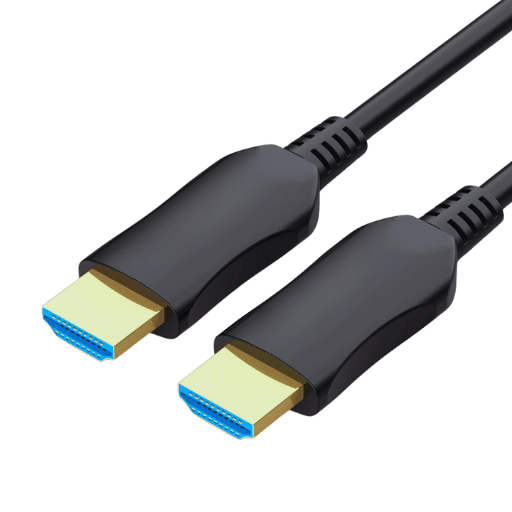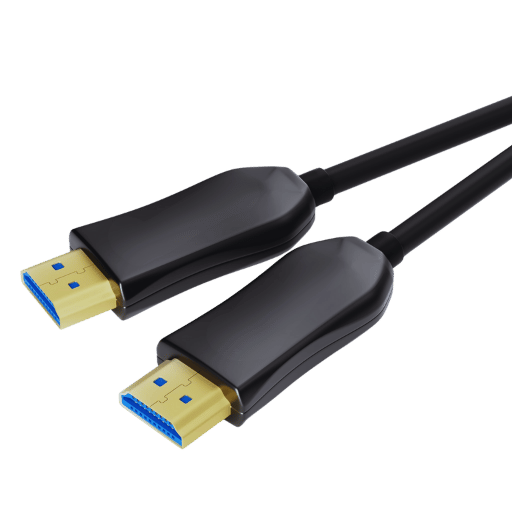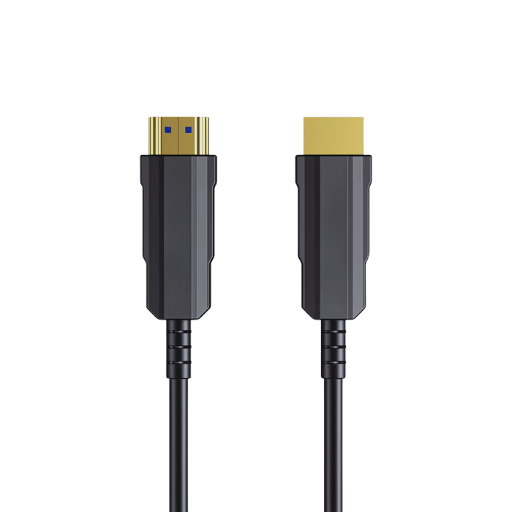When what is heard and seen is considered of utmost importance, using HDMI 4K fiber optic cables in your entertainment setup can significantly improve your viewing and listening experience. These sophisticated cords are designed to support ultra-high-definition (UHD) resolution and ensure minimum signal loss over long distances, hence giving a clean connection for gaming consoles, home theater systems, or professional AV setups. This article highlights the technical benefits, installation steps, and general merits associated with using HDMI 4K fiber optic cables, thereby providing you with the information needed to decide about your next upgrade. Whether you’re an IT professional looking for top-notch equipment or just someone who loves gadgets, our all-inclusive manual will cover everything essential to help you transform this aspect of your life.

The HDMI (High-Definition Multimedia Interface) technology is a standardized method of transferring audio and video signals through a single cable. It can deliver uncompressed digital videos and multi-channel audio with resolutions up to 4K UHD and beyond. It is made user-friendly, so it only requires one port to link different devices, such as television sets, projectors, gaming consoles, or AV receivers. Additionally, the use of fiber optics within an HDMI cable has improved its performance because these cables can now transmit for longer distances without losing signal quality, thus making them ideal for high-end home cinemas and professional audiovisual setups.
Distance of Transmission
The transmission distance is one of the main differences between fiber optic and traditional (copper) HDMI cables. Before signal degradation starts, copper-made typical HDMI cables can transmit data effectively over small distances, usually up to 50 feet. Conversely, light signals are used by fiber optic HDMI cables for longer transmission distances which can be far more than 300 feet without any loss in the quality of signals. Fiber optic HDMI cables are good for auditoriums, stadiums or large home theaters installations.
Quality of Signal
Compared to their traditional counterparts, fiber optic HDMI cables provide better signal quality. Copper HDMI cables can sometimes be affected by electromagnetic and radio frequency interference while fiber-optic ones are not susceptible to such interferences because they use light in transmitting data. This therefore guarantees reliable high-quality output with clear audio and video.
Bandwidth as well as Data Rate
Copper HDMI cables have a maximum practical bandwidth of about 18 Gbps due to their material properties and manufacturing techniques, which support 4K resolutions at a refresh rate of 60Hz. But unlike them, fiber optic HDMI cables can achieve much higher bandwidths, often exceeding 48 Gbps, thus allowing for larger resolutions like 8K at 60Hz or even 4K at 120Hz. Additionally this greater data rate enables better image quality together with supporting features such as HDR (High Dynamic Range) and wide color gamuts.
Flexibility & Endurance
In terms of durability and flexibility, traditional copper-made HDMI cords are more brittle, while their counterparts made from fibers offer more resilience plus adaptability. Thin, lightweight designs used in making fiber-optic cable allow easy installation, especially when dealing with complicated setups involving tight spaces or extensive cabling needs. Besides this fact, it also means that they will last longer before breaking down, thus having a longer life span than other types of cords.
Cost Implications
It is worth mentioning that fiber-optics-based High Definition Multimedia Interface (HDMI) cables are usually expensive upfront compared to conventional copper-based ones. Fiber optic cables are priced higher because they use advanced technology and materials during production. However, the additional price may be justified by benefits like the extended range of transmission, better quality signals, and increased bandwidth, which can be necessary for professional installations or high-end home theaters.
To summarize, while both fiber optic and traditional HDMI cables are used to transmit high definition audio visual signals over short distances, fiber optics have the upper hand due to their ability to support long-distance transmission, signal strength, bandwidth flexibility, and durability. Nevertheless, this convenience comes at a premium cost; hence, one should consider their specific requirements against available funds.
Improved Signaling Accuracy
Above all, fiber optic HDMI cords are able to maintain signal accuracy over long distances, which is one of their primary benefits. Unlike traditional copper cables that lose signal quality after a particular length, fiber optics can transmit data for more extended periods without any losses in quality — even up to 100 feet and beyond. Thus, they become perfect for big spaces or complex setups where maintaining good audio-visuals is important.
Robustness against Electromagnetic Interference (EMI)
The utilization of light instead of electric signals for transmitting information makes fibers not susceptible to electromagnetic interference (EMI). This feature enables them to work better in environments with many electronic devices that can disrupt signal quality, like control rooms or heavy machinery areas.
Greater Bandwidth Capabilities
4K and 8K video formats, among other advanced video formats that need higher bandwidths than copper wires, support it. Fiber optic HDMI cables are capable of accommodating high frame rates and multi-channel audio, too. Therefore, this extra capacity is necessary for today’s home theater applications and professional video production gaming setups, where users want to take full advantage of the latest technology available without any compromises being made at all.
To sum it up, fiber optic hdmi cables offer better signaling integrity, immunity from EMI, and improved bandwidth, thus making them an excellent choice for reliable transmission of high-quality audio-visual signals in various applications.

Bandwidth and Speeds
One must always keep in mind the bandwidth capacity and data transfer rate when choosing a 4K HDMI fiber cable. A good cable should be able to support not less than 18 Gbps which will be able to handle 4K video at 60Hz, HDR, and deep color. If you want something that is future-oriented then go for cables with 48 Gbps capability as this supports 8K together with 120Hz refresh rates.
Cable construction and durability
For sustainability reasons while still performing its duties properly the cable has to have good construction features. You need those cables which are made strong from outside by having reinforced connectors plus sturdy outer sheaths. Materials like Kevlar can be used alongside high-quality PVC so that they improve resistance against physical damages thus increasing on durability levels of this type of wires.
Device compatibility
It is important to ensure that the 4k HDMI fiber optic cable you buy works well with all your gadgets. This means checking whether it meets certain HDMI standards like HDMI 2.0 or HDMI 2.1, which determine if such a wire can support Dynamic HDR, among other features, eARC (Enhanced Audio Return Channel), variable refresh rates, etc.
Signal integrity and shielding
The maintenance of high-quality audio-visual output requires signal integrity to be observed throughout the process. Therefore one must choose only those cables that employ advanced shielding techniques aimed at reducing electromagnetic as well radio frequency interferences if any shall occur within their path ways hence ensuring clean connection together with clear signals especially where there are many electronic devices around.
Certification and compliance
International standards demand for certified compliant HDMI fiber cables; therefore, always make your selection based on this factor too! Look out for certificates given by bodies such as HDMI Licensing Administrator Inc., implying that all necessary performance safety requirements have been fulfilled during manufacturing in order for them work best .
Length & Flexibility
The length of the cable will depend on your specific setup needs; however, always ensure that you do not exceed its maximum effective transmission range. Fiber optic HDMI cables are best suited for long distances but remember they may become less flexible as length increases and this might pose challenges during installation especially where space is limited or there are complex setups involved.
Following these aspects will help in choosing the most suitable 4K HDMI fiber cable for a strong audio visual connection.
To know which HDMI is better, the audio-visual setup requirements need to be looked at. For example, HDMI 2.1 has many improvements to HDMI 2.0 because it has an increased bandwidth capacity of up to 48 Gbps (compared with only 18 Gbps in HDMI version two), thus allowing higher resolutions and refresh rates like 4K at 120Hz or even 8K @60hz. At the same time, HDMI 2 can only manage this at most. Also, Dynamic HDR is one among other advanced features incorporated into the new standard together with eARC (enhanced Audio Return Channel) as well as VRR (Variable Refresh Rate), all these being very useful for gamers and home theater enthusiasts. However, even though still being good enough for lots of standard 4k setups where it supports up to up upto60hz plus HDR, HDMI two point oh should not be disregarded since it can cater to many ordinary needs if you’re looking forward towards future-proofing your system as well as having more advanced features then I would suggest going for HDMI Version Two Dot One.
To verify if HDMI cables are compatible with 4K HDR devices, it is important to check if they carry enough bandwidth and features. Commonly known as HDMI 2.0, the most recent version supports a 60Hz refresh rate at 4K resolution, basic Audio Return Channel (ARC), and HDR10, as stated by top sources. But when it comes to complex configurations that require higher refresh rates or advanced audio capabilities, among other things such as improved color depth or greater audio capabilities, then experts recommend using HDMI 2.1 instead of HDMI2.1 cables offer more bandwidth up to 48Gbps, which is necessary for supporting higher resolutions like 120Hz at 4k or even 60 Hz at8k besides dynamic HDR support enhanced ARC channels among other features of this kind including variable refresh rates e.t.c therefore while standard content may work well with HDMI2.0, having said all these facts it becomes clear that opting for HDMI2.-1will guarantee complete compatibility of any latest feature in a device with 4KHDR hence making it future proof and better performing.

There are some critical steps involved in setting up fiber optic cables to make a successful and high-quality HDMI connection over long distances. Firstly, choose a good kit of HDMI to Fiber Optic Converter that supports the required video resolution and audio features like 4K HDR and eARC. Then, connect the HDMI source device (for example, a media player or gaming console) with a standard HDMI cable to the input port of the transmitter unit. After that, take one end of the fiber optic cable and plug it into the transmitter, run this cable up to the desired place, ensuring no bends or damages during installation, and attach another end of the fiber optic cable to the receiver unit, eventually connecting the output port of HDMI on receiver unit with the display device (TV or projector) using different HDMI cable. Power on all devices and check if signals are transmitting correctly through this arrangement. With such an arrangement, one can send HDMI signals over long distances without losing quality, which is perfect for distant installations.
When you use HDMI extenders, there are some problems that may occur and interrupt the transmission of signals. The list below shows some common issues as well as their troubleshooting steps:
No Signal or Intermittent Connection
Poor Video Quality
Audio Issues
Incompatibility With Certain Devices
Lag or Latency
Therefore, users can achieve reliable, high-quality HDMI signal transmission over extended distances by systematically following these troubleshooting steps for these common problems.

To attain 4K ultra HD resolution, you must take into account some important factors. For instance, make sure that all linked devices are compatible with 4k resolution and have HDMI 2.0 or higher ports. Employ certified high-quality HDMI fiber optic cables that can handle the higher data rate needed for a 4k display. Furthermore, keep the firmware on each device updated so as to benefit from any possible performance improvement. Finally, set up the source and display units’ display settings properly in order to get the best picture quality possible.
To experience Dolby Audio using HDMI fiber optic cables, you must meet certain technical requirements. For example, make sure all of your audio equipment (AV receivers, soundbars, and speakers) supports Dolby Audio formats. Then, only high-quality HDMI fiber optic cables that have enough bandwidth can be used to transmit high-definition audio signals. Verify that the source device, like a Blu-ray player or stream box, is set up to output Dolby Audio as well. And lastly, update all firmware to its latest version; also, ensure proper configuration of settings for both source and audio devices in order to optimize audio performance should be checked too; following these instructions will result in a perfect sounding system through HDMI fiber optics cable with Dolby Atmos sound.

Optical fiber signal transmission is comprised of transmitting light signals via a glass or plastic core. It is the best way to minimize signal loss and achieve high bandwidth over long distances. In HDMI fiber optic cables, light signals are converted into electronic signals at the transmitting end and then back into light signals at the receiving end. This process of conversion guarantees that video and audio signals of high definition can travel with little degradation or interference. The adoption of optical fiber permits faster data transfer rates, which is necessary for preserving 4K Ultra HD and Dolby Audio signals intact.
The term “uncompressed data” is used to describe audio and video signals that have not been compressed in any way to reduce their size. This applies specifically to HDMI fiber optic cables, where it is necessary to maintain the best possible sound and picture quality. The bandwidth needed for transmitting uncompressed information is much larger than what would be required by compressed files – for example, a 60fps 4K Ultra HD video without compression needs about 18 gigabits per second (Gbps). With such high bandwidths, each pixel or sound bite can be sent through without losing anything; thus, this saves the initial state of the content.
To facilitate the transmission of this type of high-bandwidth uncompressed data, there are HDMI standards like HDMI 2.0 and HDMI 2.1. HDMI 2.0 has a maximum capacity of up to 18 Gbps which supports full-resolution UHD (Ultra High Definition) at up to 60 frames per second with an 8-bit color depth while HDMI version two point one offers increased capabilities such as supporting resolutions beyond four thousand pixels wide along with HDR (high dynamic range) and advanced audio formats like DTS:X and Dolby Atmos; it also increases the ceiling for bandwidth up to forty-eight gigabits per second opening doors for things like being able to do eight thousand pixel width resolution videos at sixty frames per second or even four thousand pixel width resolution videos at one hundred twenty frames per second.
By using an HDMI fiber optic cable capable of dealing with these higher bandwidth requirements, you will minimize signal loss or degradation between devices, ensuring greater fidelity in both audio playback systems as well as visual displays, whether they may be professional-grade home theaters/broadcasting stations or top tier gaming setups -essentially anywhere where sound quality matters most – so being able to transmit inputs in their original format should always remain as our ultimate aim!

HDMI fiber optic cables are particularly ideal for connecting projectors, especially where high-resolution content and longer cable runs are required. Traditionally, copper HDMI cables suffer from signal degradation and attenuation over long distances due to the fact that projectors often have to deal with large separations between the source and display. This is where HDMI fiber optic cables come in handy.
The main advantage of using HDMI fiber optic cables for projectors is that they can transmit uncompressed data across very long distances without any loss of quality. These cables can handle 4K video at 60 fps or even 8K video at 60 fps with HDR, thereby ensuring that the content stays sharp, vibrant, and true to its original form. For example, a copper HDMI cable may start having signal integrity issues beyond 50 feet while still not meeting the full bandwidth requirements of higher resolutions but an HDMI fiber optic cable will cover around 300 feet or more without compromising on either aspect.
Another important consideration is data integrity; this means that electromagnetic interference (EMI) and radio-frequency interference (RFI) tend not affect HDMI fibre optic cables as much as other types which makes them more reliable in environments with a lot electronic devices around them since it ensures a stable link is maintained at all times hence preventing any loss of rich audio or video due to lack of enough bandwidth.
Additionally these kinds of wires weigh less than their copper counterparts thus making installation easy whether one wants to permanently set up something or just do so temporarily. The flexibility associated with them also enables people use different areas such as home theaters, conference rooms among others where projectors might be situated far away from source devices.
To sum it up, HDMI fibre optics offer strong solutions for projectors because they provide sufficient breadth as well as length capabilities needed for great viewing experience without compromising on signal quality during transmission processes.
Using multiple HDMI inputs and outputs ensures seamless connectivity and greater control over different audiovisual sources as well as display media. In this setup, you cannot do without HDMI splitters and switchers. An HDMI splitter is a device that takes one input source and sends it to many output displays, thereby making it possible to broadcast a presentation on several screens simultaneously. On the contrary, an HDMI switcher accepts inputs from various devices so that users can scroll through different sources on only one output display, such as switching between a Blu-ray player, gaming console, and cable box on one TV.
In addition to this, matrix switchers combine both functionalities, hence providing independent routing of multiple input sources to multiple output displays, for example, in conference rooms or educational institutions or even home theaters where there is a need for interconnection between numerous devices and screens which may be quite complicated at times. It is important to ensure that they are compatible with such advanced HDMI standards as HDMI 2.1 because this guarantees the wider bandwidth necessary for higher resolution content, including 4K and 8K videos with HDR support. With these gadgets used appropriately, people can create very flexible systems of audio-video representation that work efficiently, too.
A: A fiber optic HDMI cable is an advanced type of cable that can transmit high-definition video and audio signals over longer distances without any loss of quality. It uses high-quality glass fibers to ensure the pure transmission of signals.
A: A fiber HDMI cable guarantees excellent video and audio quality, and it can comfortably handle 60Hz and higher bandwidth signals, including 4K@60Hz or even 8K resolutions. It reduces signal loss and interference, ensuring a clear and reliable connection.
A: Yes, it supports refresh rates of 60Hz and beyond, making it ideal for gaming or watching 4K UHD movies with smooth video playback.
A: Its main advantages include long-distance HD transmission without degradation, immunity to electromagnetic interference, and high durability due to its glass fiber construction.
A: These cables are fully compliant with HDCP (High-bandwidth Digital Content Protection), enabling protected content to be securely transmitted.
A : Yes , you can use an optical HDMI cable with devices like Apple TV 4k which will help you take full advantage of your streaming device’s HD capabilities .
A: In contrast to conventional copper-based cables, HDMI2.0 fiber optic cables employ state-of-the-art technology that allows them to have greater bandwidths (up to 18 Gbps), support ultra-high-definition resolutions such as 4k and 8k, and travel longer distances without signal degradation.
A: Optical HDMI cables can connect a wide range of equipment that requires high-quality video and audio transmission, such as 4K projectors, HDTVs, gaming consoles, and Blu-ray players.
A: Yes, different adapters can convert fiber HDMI connections to other types of connections, like different HDMI versions or even Ethernet or VGA, for greater flexibility with various devices.